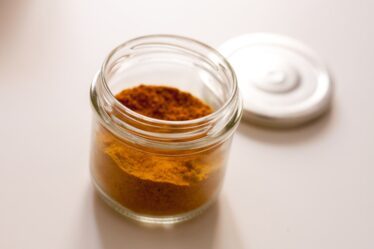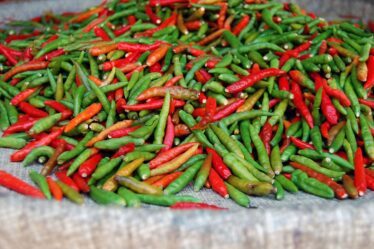
Korean chili flakes, also known as gochugaru, are a staple ingredient in Korean cuisine. They are made from dried red chili peppers that have been ground into flakes. The history of Korean chili flakes dates back centuries, with the cultivation of chili peppers in Korea believed to have started in the 16th century. The unique flavor and heat of Korean chili flakes have made them a popular ingredient in many traditional Korean dishes.
Korean chili flakes are commonly used in a variety of Korean dishes, including kimchi, bulgogi, and tteokbokki. They add a spicy kick and a vibrant red color to these dishes. Korean chili flakes are also used to make gochujang, a fermented chili paste that is a staple in Korean cooking. The combination of heat and flavor that Korean chili flakes provide is essential to achieving the authentic taste of Korean cuisine.
Key Takeaways
- Korean chili flakes, also known as gochugaru, are a staple in Korean cuisine.
- Substitutes for Korean chili flakes are important for those who cannot find them or have allergies.
- Red pepper flakes can be used as a substitute for Korean chili flakes, but they have a different flavor profile.
- Paprika can be used as a substitute for Korean chili flakes, but it is milder and sweeter.
- Cayenne pepper can be used as a substitute for Korean chili flakes, but it is much spicier.
The Importance of Substitutes
There may be times when you need to substitute Korean chili flakes in a recipe. Perhaps you can’t find them at your local grocery store, or maybe you have run out and need a quick alternative. Whatever the reason, it’s important to choose the right substitute to ensure that your dish still has the desired flavor profile.
When choosing a substitute for Korean chili flakes, it’s important to consider the heat level and flavor profile of the original ingredient. Korean chili flakes have a medium level of heat and a slightly smoky and fruity flavor. Finding a substitute that can replicate these characteristics will help maintain the authenticity of your dish.
Red Pepper Flakes as a Substitute
One common substitute for Korean chili flakes is red pepper flakes. While they may seem similar, there are some differences between the two. Red pepper flakes are typically made from dried cayenne peppers and have a higher heat level than Korean chili flakes. They also have a slightly different flavor profile, with a more intense heat and a less fruity taste.
To use red pepper flakes as a substitute for Korean chili flakes in Korean dishes, you can simply use them in the same quantity as the original recipe calls for. However, keep in mind that the dish may be spicier than intended due to the higher heat level of red pepper flakes. Adjust the amount of red pepper flakes to your personal preference.
Paprika as a Substitute
| Substitute | Flavor | Heat Level | Color |
|---|---|---|---|
| Cayenne Pepper | Spicy, earthy | High | Reddish-brown |
| Chili Powder | Spicy, smoky | Medium-high | Reddish-brown |
| Smoked Paprika | Smoky, sweet | Low | Reddish-brown |
| Cumin | Earthy, nutty | Low | Brown |
Paprika is another substitute for Korean chili flakes that can be used in certain dishes. Paprika is made from ground dried peppers, but it is typically made from sweet or mild peppers rather than spicy ones. As a result, paprika has a milder heat level compared to Korean chili flakes.
The flavor profile of paprika is also different from Korean chili flakes. Paprika has a sweet and slightly smoky taste, which can add depth to your dish. If you choose to use paprika as a substitute for Korean chili flakes, keep in mind that it will not provide the same level of heat. You may need to add additional spices or ingredients to achieve the desired level of spiciness.
Cayenne Pepper as a Substitute
Cayenne pepper is another substitute for Korean chili flakes that can be used when you need a spicy kick in your dish. Cayenne pepper is made from ground dried cayenne peppers and has a high heat level, similar to red pepper flakes. However, cayenne pepper has a slightly different flavor profile, with a more intense heat and a hint of sweetness.
To use cayenne pepper as a substitute for Korean chili flakes in Korean dishes, you can use it in the same quantity as the original recipe calls for. However, keep in mind that cayenne pepper is hotter than Korean chili flakes, so adjust the amount according to your personal preference.
Crushed Red Pepper as a Substitute

Crushed red pepper is another substitute for Korean chili flakes that can be used in certain dishes. While they may seem similar, there are some differences between the two. Crushed red pepper is typically made from a variety of dried chili peppers and has a higher heat level than Korean chili flakes. It also has a slightly different flavor profile, with a more intense heat and a less fruity taste.
To use crushed red pepper as a substitute for Korean chili flakes in Korean dishes, you can simply use them in the same quantity as the original recipe calls for. However, keep in mind that the dish may be spicier than intended due to the higher heat level of crushed red pepper. Adjust the amount of crushed red pepper to your personal preference.
Gochujang as a Substitute
Gochujang is a fermented chili paste that is commonly used in Korean cuisine. It is made from Korean chili flakes, rice or barley, and soybeans. While gochujang is not a direct substitute for Korean chili flakes, it can be used in certain dishes to add both heat and flavor.
To use gochujang as a substitute for Korean chili flakes in Korean dishes, you can add it to your dish in the same quantity as the original recipe calls for. Keep in mind that gochujang has a thicker consistency than Korean chili flakes, so you may need to adjust the amount of other liquids in your recipe.
Sambal Oelek as a Substitute
Sambal oelek is a spicy chili paste that is commonly used in Southeast Asian cuisine. It is made from ground fresh red chili peppers, vinegar, and salt. While sambal oelek is not a direct substitute for Korean chili flakes, it can be used in certain dishes to add both heat and flavor.
To use sambal oelek as a substitute for Korean chili flakes in Korean dishes, you can add it to your dish in the same quantity as the original recipe calls for. Keep in mind that sambal oelek has a different flavor profile than Korean chili flakes, so the taste of your dish may be slightly different.
Aleppo Pepper Flakes as a Substitute
Aleppo pepper flakes are a unique substitute for Korean chili flakes that can add a different flavor profile to your dish. Aleppo pepper flakes are made from dried Aleppo peppers, which have a fruity and slightly smoky flavor. They have a medium heat level, similar to Korean chili flakes.
To use Aleppo pepper flakes as a substitute for Korean chili flakes in Korean dishes, you can use them in the same quantity as the original recipe calls for. Keep in mind that Aleppo pepper flakes have a different flavor profile than Korean chili flakes, so the taste of your dish may be slightly different.
Choosing the Right Substitute for Your Dish
When choosing a substitute for Korean chili flakes, there are several factors to consider. First, consider the heat level of the substitute and how it compares to Korean chili flakes. If you prefer a milder dish, choose a substitute with a lower heat level. If you prefer a spicier dish, choose a substitute with a higher heat level.
Second, consider the flavor profile of the substitute and how it compares to Korean chili flakes. If you want to replicate the fruity and slightly smoky flavor of Korean chili flakes, choose a substitute with similar characteristics. If you want to experiment with different flavors, choose a substitute with a different flavor profile.
Finally, consider the texture and consistency of the substitute and how it will affect your dish. Some substitutes, like gochujang and sambal oelek, have a thicker consistency than Korean chili flakes. Adjust the amount of other liquids in your recipe accordingly.
In conclusion, Korean chili flakes are an essential ingredient in Korean cuisine, but there may be times when you need to substitute them in a recipe. Red pepper flakes, paprika, cayenne pepper, crushed red pepper, gochujang, sambal oelek, and Aleppo pepper flakes are all viable substitutes that can add heat and flavor to your dish. When choosing a substitute, consider the heat level, flavor profile, and texture of the substitute and how it compares to Korean chili flakes. Don’t be afraid to experiment with different substitutes to find your favorite flavor profile.
Looking for a substitute for Korean chili flakes? Check out this in-depth analysis of the Surinam cherry on Flavorful Sips. This article explores the unique flavor profile and uses of this tropical fruit, making it a potential alternative to spice up your dishes. Discover how the Surinam cherry can add a tangy and slightly sweet kick to your recipes. To learn more, click here.



